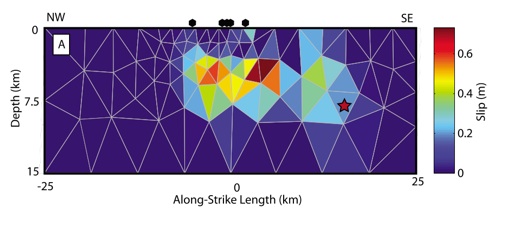



Alpine-Himalaya Belt Seismicity
High-Resolution Topography of Earthquakes
InSAR and Optical Geodesy
Earthquake Cycle Deformation
1 - 4
<
>

Software @ University of Iowa
Encountering bugs or issues? Email me: william-barnhart-1@uiowa.edu
--------------------------------------------------------------------------------------------------
InSamp: InSAR Downsampler and Covariance Estimator
InSamp is a suite of MATLAB scripts and functions that allow you to downsample a full resolution interferogram into a data set that is tractable for inversions. The algorithm variably resamples interferograms to allow for more observations points close to the location of surface deformation. Instead of resampling based on gradients in the deformation field, InSamp uses a user-defined starting model for the source of the deformation. InSamp generates downsampled meshes using the open source Mesh2D unstructured meshing tool developed by D. Engwirda (https://www.mathworks.com/matlabcentral/fileexchange/25555-mesh2d-delaunay-based-unstructured-mesh-generation)
In addition to downsampling data, InSamp generates an estimate of the full covariance structure of the downsampled interferograms. This allows the user to include noise information that is representative of the true, spatially varying noise structure.
Currently Supported Processor:
ISCE
GMTSAR
ROI-PAC
InSAMP.tar (v1.4)
Includes a README file and example data Sentinel-1 data set processed using the JPL/Caltech ISCE procesing package
Reference:
Lohman, R. B., and W. D. Barnhart (2010), Evaluation of earthquake triggering during the 2005-2008 earthquake sequence on Qeshm Island, Iran, J. Geophys. Res. Solid Earth, 115, 12413, doi:10.1029/2010JB007710.
Lohman, R. B., and M. Simons (2005), Some thoughts on the use of InSAR data to constrain models of surface deformation: Noise structure and data downsampling, Geochem. Geophys. Geosystems, 6(1), n/a–n/a, doi:10.1029/2004GC000841.

--------------------------------------------------------------------------------------------------
FaultResampler
The FaultResampler program is designed for fault-slip inversions from geodetic data (GPS, InSAR, optical offsets, etc.). The idea is simple: Inversion resolution (what you can actually say about fault slip) is fundamentally dependent on the quality of your data and the location of your data relative to the fault plane. This idea plays the greatest part in where on the fault you can resolve slip well. Near data points, you have good resolution of slip; far from data points, you have poor resolution. FaultResampler iteratively discretizes an input fault model to produce a fault model and slip distribution that accurately reflect the resolution power of your data.
*** All slip distributions on the Slip Models page are derived using this algorithm ***
Reference: Barnhart, W.D., Lohman, R.B. (2010) Automated fault model discretization for inversions for coseismic slip distributions, J. Geophys. Res. 115, B10419.

Slip distribution of the 2004 Parkfield earthquake from GPS measurements. Fault patches vary in size according to the resolution power of the available data. Barnhart & Lohman 2010.
FaultResampler.tar (v1.4)
Includes a README with references for other codes you will need for calculating Greens Functions. NOTE: This version includes a fix for the defunct command tsearch.m in Mesh2D. You will still need to download Mesh2D as described in the README, then replace the programs meshfaces.m and mytsearch.m with the files included in this distribution.
-----------------------------------------------------------------------------------------------
